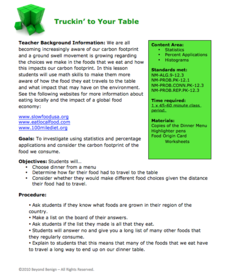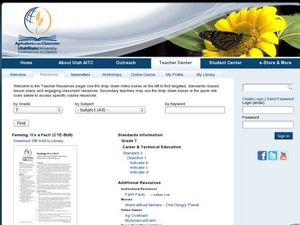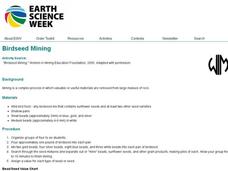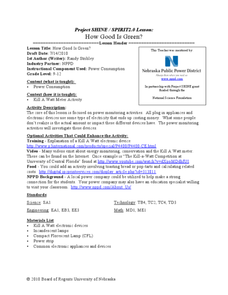Curated OER
Calculating Your Foodometer
Students explore environmental issues by completing a food production class activity. In this carbon footprint lesson, students discuss the types of foods they eat, where they come from and what types of methods are used to transport...
Curated OER
The Quicker the Better? Food Processing
Sixth graders evaluate the nutrition of various foods. In this healthy eating lesson plan, 6th graders discuss the processing of many common foods and what this means. Students identify and research unfamiliar ingredients in processed...
Beyond Benign
Truckin’ to Your Table
Food takes a trip to the table. Class members choose a meal from a menu and calculate the total cost of the meal including tax and tip. Using a food origin card, pupils determine how far each of the ingredients of a meal traveled to end...
Curated OER
Farming: It's a Fact!
Students use worksheets, food items, and computer programs to learn about the path of food from the farm to their meals. In this agriculture lesson, students use a provided worksheet to learn facts about farming. They use a bag of...
Curated OER
Ocean Market
Students identify some consumer goods that come from the ocean.
They classify these items into groups, identify their source, and calculate the cost of buying such goods.
Curated OER
Filling Up-Gasoline
In this fuel sources worksheet, students calculate the E85 alternative fuel costs per gallon compared to the cost of gasoline. Students complete a table to show the comparison prices. They create a triple line graph to show the...
Learning Games Lab
Nitrogen in Fertilizer
Nitrogen is an essential element for productive farming. An interactive lesson explores the chemical makeup of different fertilizers and their corresponding nitrogen content. The interactive challenges individuals to complete...
Curated OER
Benefits of Indoor Plants
Students diagram a plant. In this Science lesson, students explore the concept of photosynthesis focusing on the oxygen production. Students calculate the amount of plants needed to filter the air in their classroom.
Curated OER
Birdseed Mining
Students explore the meaning of mining. In this Science/Math lesson, students engage in a small group activity to sort and calculate the value of seeds/beads. Additionally, they are made aware of environmental damages which will...
Curated OER
Power Problem
Students complete an electricity activity to learn about power outages, insurance, and weather preparation. Students use the worksheet 'Power Problem Work Sheet' and use the 'Global Grocery List Project price list for the U.S.' to...
Curated OER
Add and Subtract with Hudson River shipping
Rivers aren't just a place for animals to live, they also provide industrial transportation. The class will examine the Hudson River on a map, discuss all the commercial vessels that use the River to transport materials, then complete a...
Curated OER
Trophic Ecology of Humans
students analyze the place of humans among the tropic levels by observing what we eat. They calculate the caloric content of several foods commonly eaten by humans and calculate the total energy cost to grow, process, transport, store...
Curated OER
Trophic Ecology of Humans
Students analyze the trophic level of humans by first calculating the kilocalories in own their lunch. They then calulate the kilocalories in a wide variety of foods found in grocery stores and compare the kilocalories needed to acquire...
Curated OER
Compound Interest
For this compound interest worksheet, students solve 3 problems after reading about compound interest. They determine the cost of the Apollo missions, they calculate inflation and the cost it would be to send man to the moon today and...
Curated OER
What The Peanuts Say: Catabolism and Calories
Students investigate the energy released by a peanut and a piece of a walnut. In this catabolism and calories lesson plan, students burn a peanut and a piece of a walnut and measure the temperature of the water before burning and after...
Curated OER
Pumped Up Gas Prices
Students calculate gas prices. In this transportation lesson, students tally the mileage and gas costs of their car for one months. They figure out how much was spent on gas and create a graph showing average gas prices over time.
Curated OER
Canine Companions
Learners identify the responsibilities of being a dog owner. In this animal welfare lesson, students list ten important items that a dog needs to live and visit a pet store to calculate the total cost of the items. Learners visit a local...
Curated OER
Drip, Drip, Drip or The Case of the Leaky Faucet
Students explore the cost of wasted water. In this math lesson plan, students conduct an experiment in which they collect data on how much water is lost when a faucet leaks. Students figure the cost of the water that was wasted.
Curated OER
How Good Is Green?
High schoolers explore the amount of electricity used and wasted in homes and at school using kilowatt meters. In this environmental energy lesson, students compute power usage by appliances over time and identify ways in which...
Teach Engineering
Hydrogen-Oxygen Reaction Lab
High schoolers conduct an experiment using the reaction of hydrogen and oxygen. After pairs balance the chemical equation for making water, they mix different ratios of hydrogen and oxygen in a chemical reaction. Classmates...
Curated OER
Global Warming Statistics
Students research real-time and historic temperature data of U.S. and world locations, and analyze the data using mean, median, and mode averages. They graph the data and draw conclusions by analyzing the data. A spreadsheet is used to...
Curated OER
TE Activity: Trash Talkin'
Students collect and categorize solid waste produced in the classroom. They weigh the waste that has been collected over one week's time, and separate it into recyclable and non-recyclable waste. They talk about the role of engineers in...
Curated OER
Integrating Science and Literacy Through Novel Studies
You can use "The Toothpaste Millionaire" and other outstanding fiction to integrate science and literacy.
Curated OER
It's In the Numbers
High schoolers explore the careers available in the field of oceanography. They discover the difference between a job and a career and the need for a good education. They work together to create a presentation about oceanography.























